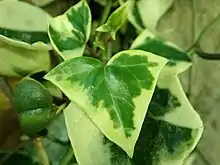| Senecio macroglossus | |
|---|---|
 | |
| Scientific classification | |
| Kingdom: | Plantae |
| Clade: | Tracheophytes |
| Clade: | Angiosperms |
| Clade: | Eudicots |
| Clade: | Asterids |
| Order: | Asterales |
| Family: | Asteraceae |
| Genus: | Senecio |
| Species: | S. macroglossus |
| Binomial name | |
| Senecio macroglossus | |
Senecio macroglossus, the Natal ivy, marguerite ivy, climbing senecio or wax ivy, is a species of flowering plant in the family Asteraceae, native to southern Africa, from Zimbabwe and Mozambique to eastern South Africa.
Name

Despite its common name, and its resemblance to common ivy, it is not closely related to that group of plants. The Latin specific epithet macroglossus means "large tongue".[1]
Description
Growing to 3 m (10 ft) or more, it is an evergreen climber with waxy triangular leaves to 8 cm (3 in) long.
Single, yellow, daisy-like composite flowerheads are borne in summer.[2]
Cultivation
With a minimum temperature of 5–7 °C (41–45 °F), it is frequently grown as a houseplant in temperate regions. Numerous cultivars have been developed, of which 'Variegatus', with cream-coloured leaf margins, has gained the Royal Horticultural Society's Award of Garden Merit.[3][4]
References
- ↑ Harrison, Lorraine (2012). RHS Latin for gardeners. United Kingdom: Mitchell Beazley. p. 224. ISBN 9781845337315.
- ↑ RHS A-Z encyclopedia of garden plants. United Kingdom: Dorling Kindersley. 2008. p. 1136. ISBN 978-1405332965.
- ↑ "RHS Plant Selector - Senecio macroglossus 'Variegatus'". Retrieved 23 February 2020.
- ↑ "AGM Plants - Ornamental" (PDF). Royal Horticultural Society. July 2017. p. 96. Retrieved 10 November 2018.